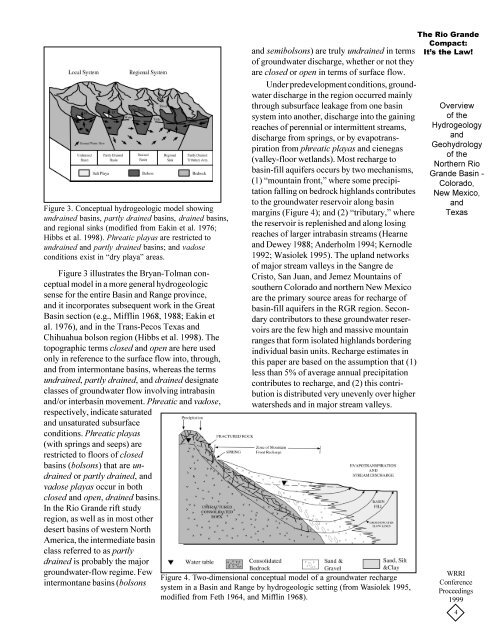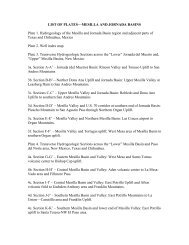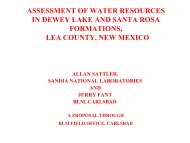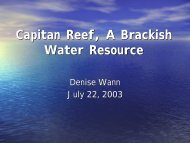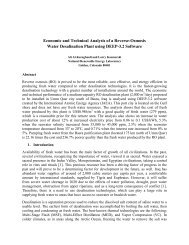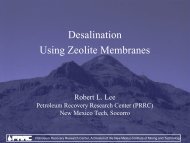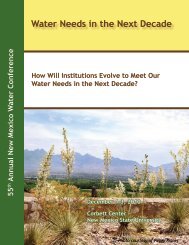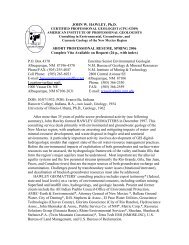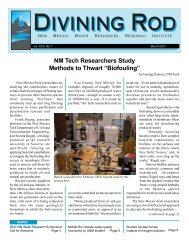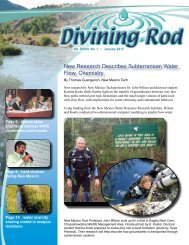Overview of the Groundwater Hydrology of the Rio Grande Basin
Overview of the Groundwater Hydrology of the Rio Grande Basin
Overview of the Groundwater Hydrology of the Rio Grande Basin
You also want an ePaper? Increase the reach of your titles
YUMPU automatically turns print PDFs into web optimized ePapers that Google loves.
Figure 3. Conceptual hydrogeologic model showingundrained basins, partly drained basins, drained basins,and regional sinks (modified from Eakin et al. 1976;Hibbs et al. 1998). Phreatic playas are restricted toundrained and partly drained basins; and vadoseconditions exist in “dry playa” areas.Figure 3 illustrates <strong>the</strong> Bryan-Tolman conceptualmodel in a more general hydrogeologicsense for <strong>the</strong> entire <strong>Basin</strong> and Range province,and it incorporates subsequent work in <strong>the</strong> Great<strong>Basin</strong> section (e.g., Mifflin 1968, 1988; Eakin etal. 1976), and in <strong>the</strong> Trans-Pecos Texas andChihuahua bolson region (Hibbs et al. 1998). Thetopographic terms closed and open are here usedonly in reference to <strong>the</strong> surface flow into, through,and from intermontane basins, whereas <strong>the</strong> termsundrained, partly drained, and drained designateclasses <strong>of</strong> groundwater flow involving intrabasinand/or interbasin movement. Phreatic and vadose,respectively, indicate saturatedand unsaturated subsurfaceconditions. Phreatic playas(with springs and seeps) arerestricted to floors <strong>of</strong> closedbasins (bolsons) that are undrainedor partly drained, andvadose playas occur in bothclosed and open, drained basins.In <strong>the</strong> <strong>Rio</strong> <strong>Grande</strong> rift studyregion, as well as in most o<strong>the</strong>rdesert basins <strong>of</strong> western NorthAmerica, <strong>the</strong> intermediate basinclass referred to as partlydrained is probably <strong>the</strong> majorgroundwater-flow regime. Fewintermontane basins (bolsonsand semibolsons) are truly undrained in terms<strong>of</strong> groundwater discharge, whe<strong>the</strong>r or not <strong>the</strong>yare closed or open in terms <strong>of</strong> surface flow.Under predevelopment conditions, groundwaterdischarge in <strong>the</strong> region occurred mainlythrough subsurface leakage from one basinsystem into ano<strong>the</strong>r, discharge into <strong>the</strong> gainingreaches <strong>of</strong> perennial or intermittent streams,discharge from springs, or by evapotranspirationfrom phreatic playas and cienegas(valley-floor wetlands). Most recharge tobasin-fill aquifers occurs by two mechanisms,(1) “mountain front,” where some precipitationfalling on bedrock highlands contributesto <strong>the</strong> groundwater reservoir along basinmargins (Figure 4); and (2) “tributary,” where<strong>the</strong> reservoir is replenished and along losingreaches <strong>of</strong> larger intrabasin streams (Hearneand Dewey 1988; Anderholm 1994; Kernodle1992; Wasiolek 1995). The upland networks<strong>of</strong> major stream valleys in <strong>the</strong> Sangre deCristo, San Juan, and Jemez Mountains <strong>of</strong>sou<strong>the</strong>rn Colorado and nor<strong>the</strong>rn New Mexicoare <strong>the</strong> primary source areas for recharge <strong>of</strong>basin-fill aquifers in <strong>the</strong> RGR region. Secondarycontributors to <strong>the</strong>se groundwater reservoirsare <strong>the</strong> few high and massive mountainranges that form isolated highlands borderingindividual basin units. Recharge estimates inthis paper are based on <strong>the</strong> assumption that (1)less than 5% <strong>of</strong> average annual precipitationcontributes to recharge, and (2) this contributionis distributed very unevenly over higherwatersheds and in major stream valleys.Figure 4. Two-dimensional conceptual model <strong>of</strong> a groundwater rechargesystem in a <strong>Basin</strong> and Range by hydrogeologic setting (from Wasiolek 1995,modified from Feth 1964, and Mifflin 1968).The <strong>Rio</strong> <strong>Grande</strong>Compact:It’s <strong>the</strong> Law!<strong>Overview</strong><strong>of</strong> <strong>the</strong>HydrogeologyandGeohydrology<strong>of</strong> <strong>the</strong>Nor<strong>the</strong>rn <strong>Rio</strong><strong>Grande</strong> <strong>Basin</strong> -Colorado,New Mexico,andTexasWRRIConferenceProceedings19994


